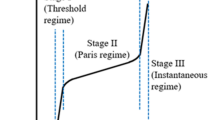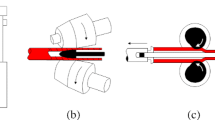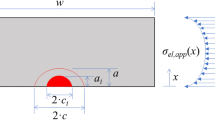Abstract
AISI type M3 class 2 tool steel (or in German designation DIN: HS6-5-3 tool steel) is most commonly used in tooling industry, and also in some engine parts. Those components are usually subjected to cyclic stresses and mostly fail by fatigue. Fatigue crack initiation in this material occupies large fraction of total lifetime and strongly depends on microstructural features of primary and eutectic carbides, such as shape, shape ratio, volume fraction, the distribution of carbides as well as load ratio. To model fatigue initiation mechanisms of forged M3:2 tool steel, McDowell’s model was modified and developed for different length-scales. For fatigue crack formation and short crack growth, a hierarchical approach was used and the life time of these stages were estimated based on the local cyclic plasticity. Through this relation the effect of microstructural features on both fatigue crack formation and short crack growth in the material were identified. The results of the proposed model have explicitly reflected the influence of microstructural features on both fatigue crack formation and propagation in forged M3:2 tool steel. Moreover, the model can be used for improving the fatigue resistance of a tool steel component.







Similar content being viewed by others
Abbreviations
- \(a\) :
-
Crack length
- \(a_{inc}\) :
-
Crack incubation length
- \(a_{o}\) :
-
Critical defect
- \(a_{sc}\) :
-
Short crack length
- \(\alpha \) :
-
Manson–Coffin law’s exponent
- \(b\) :
-
Fatigue ductility exponent
- \(c\) :
-
Kinematic hardening modulus
- \(C_{inc}\) :
-
Manson–Coffin law’s coefficient
- \(C_{\varepsilon }\) :
-
Constraint coefficient
- \(d_{o}\) :
-
Dislocation barries spacing
- \(D_{p}\) :
-
Average diameter of carbides
- \(\varDelta {CTOD}\) :
-
Crack Tip Opening Diplacement
- \(\varDelta {\varGamma }\) :
-
Fatemi–Socie parameter
- \(\varDelta {K}\) :
-
Stress intensity factor
- \(\varDelta {K_{th}}\) :
-
Threshold for long crack
- \(\varDelta {K_{th,a}}\) :
-
Threshold for short crack
- \(\frac{da}{dN}\) :
-
Crack growth rate
- \(E\) :
-
Young modulus
- \(\varepsilon '_{f}\) :
-
Fatigue ductility coefficient
- \(F\) :
-
Strengthening ratio
- \(HCF\) :
-
High Cycle Fatigue
- \(h/w\) :
-
Shape ratio of primary carbide
- \(K'\) :
-
Cyclic hardening coefficient
- \(LCF\) :
-
Low Cycle Fatigue
- \(MSF\) :
-
Multi-Stage Fatigue
- \(n'\) :
-
Cyclic hardening exponent
- \(N_{lc}\) :
-
Long crack life
- \(N_{inc}\) :
-
Fatigue crack incubation life
- \(N_{msc}\) :
-
Lifetime of microstructurally short crack
- \(N_{psc}\) :
-
Lifetime of physically short crack
- \(N_{T}\) :
-
Total lifetime
- \(r\) :
-
Dynamic rate of back stress tensor
- \(R_{\varepsilon }\) :
-
Load ratio
- \(RVE\) :
-
Representative Volume Element
- \(\varPhi \) :
-
Yield surface
- \(s\) :
-
Striation spacing
- \(S_{p}\) :
-
Average distance of primary carbides
- \(\sigma _{y,m}\) :
-
Cyclic yield stress of the matrix
- \(\sigma '_{y}\) :
-
Cyclic yield strength
- \(\sigma _{ys}\) :
-
Yield strength
- \(\sigma _{ult}\) :
-
Ultimate tensile strength
- \(Y\) :
-
Geometry factor
- \(U\) :
-
A function of load ratio
- \(V_{m}\) :
-
Volume fraction of the matrix
- \(V_{p}\) :
-
Volume fraction of primary carbides
References
Antretter T, Fischer FD (1997) Critical shapes and arrangement of carbides in high-speed tool steel. Metar Sci Eng A 237:6–11
Berns H, Broeckmann C, Hinz HF: Creep of high speed steels, Part I-experimental investigation. In: 6th international tooling conference. Karlstad, Sweden, pp 325–348 (2002)
Berns H, Lueg J, Trojahn W, Waehling R, Wisell H (1987) Fatigue behavior of conventional and powder metallurgical high speed steel. Powder Metall Int 19:22–26
Berns H, Melander A, Weichert D, Asnafi N, Broeckmann C, Gross-Weege A (1998) A new material for cold forging tools. Comput Mater Sci 11:166–180
Berns H, Trojahn W (1985) Einfluss der Waermebehandlung auf das Ermuedungsverhalten ledeburitischer Kaltarbeitsstaehle. VDI-Z 127:889–892
Broeckmann C (2001) Kriechen partikel-verstaerkter metallischer Werkstoffe. VDI Verlag GmbH, Duesseldorf
Broeckmann C, Packeisen A, Theisen W: Fatigue of carbide rich materials. In: 7th international tooling conference. Torino, Italy, pp 3–12 (2006)
Brondsted P, Skov-Hansen P (1998) Fatigue properties of high-strength materials used in cold-forging tools. Int J Fatigue 20:373–381
Bruzii MS, McHugh PE (2004) Micromechanical investigation of the fatigue crack growth behaviour of Al-SiC MMCs. Int J Fatigue 26:795–804
Chan KS (1993) Scaling laws for fatigue crack growth of large cracks in steels. Metall Trans A 24:2474–2485
Chapetti MD (2003) Fatigue propagation threshold of short cracks under constant amplitude loading. Int J Fatigue 25:1319–1326
Chawla N, Deng X (2005) Microstructure and mechanical behavior of porous sintered steels. Metar Sci Eng A 390:98–112
Coffin LFJ (1954) A study of the effects of cyclic thermal stresses on a ductile metal. Trans Am Soc Mech Eng 76:931–950
Ding HZ, Biermann H, Hartmann O (2002a) A low cycle fatigue model of a short-fibre reinforced 6061 aluminium alloy metal matrix composite. Compos Sci Technol 62:2189–2199
Ding HZ, Biermann H, Hartmann O (2003) A low cycle fatigue crack growth and life prediction of a short-fibre reinforced metal matrix composite. Mater Sci Eng A 333:295–305
Ding HZ, Biermann H, Hartmann O, Mughrabi H (2002b) Modelling low-cycle fatigue life of particulate-reinforced metal matrix composites. Compos Sci Technol 62:2189–2199
Ding HZ, Mughrabi H, Hoeppel HW (2002c) A low cycle fatigue prediction model of ultrafine-grained metal. Fract Eng Mater Struct 25:975–984
Fan J, McDowell DL, Horstemeyer MF, Gall K (2003) Cyclic plasticity at pores and inclusions in cast Al-Si alloys. Eng Fract Mech 70:1281–1302
Fatemi A, Socie D (1988) A critical plane approach to multiaxial fatigue damage including out-of-phase loading. Fatigue Fract Eng Mater Struct 11(3):145–165
Feyel F (1999) Multiscale FE2 elastoplastic analysis of composite structure. Comput Mater Sci 16:344–354
Fredriksson, G., Bergstroem, J., Hogmark, S.: Crack growth in cold work tool steels-influence of surface condition, microstructure and hardness. In: 6th International tooling conference. Karlstard, Sweeden, pp 125–135 (2002)
Friend CM (1987) The effect of matrix properties on reinforcement in short alumina fibre-aluminium metal matrix composites. J Mater Sci Eng 22:3005–3010
Fukaura K, Yokoyama Y, Yokoi D, Tsujii N, Ono K (2004) Fatigue of cold-work tool steels: effect of heat treatment and carbide morphology on fatigue crack formation, life, and fracture surface observations. Matall Meter Trans A 35:1289–1300
Gall K, Horstemeyer MF, Degner BW, McDowell DL, Fan J (2001) On the driving force for fatigue crack formation from inclusions and voids in a cast A356 Aluminum alloy. Int J Fracture 108:207–233
Giang, NA, Bezold A, Broeckmann C: Simulation of fatigue crack incubation of casted/forged HS6-5-3 tool steel under HCF regime. In: 3rd fatigue symposium. Leoben, Austria, pp 6–25 (2012)
Gitman IM, Askes H, Sluys LJ (2007) Representative volume: existence and size determination. Eng Fract Mech 74:2518–2534
Goh CH, Wallace JM, Neu RW, McDowell DL (2001) Polycrystal plasticity simulations of fretting fatigue. Int J Fatigue 23:423–435
Guinea GV, Pastor JY, Planas J, Elisces M (1998) Stress intensity factor, compliance and CMOD for a general three-point-bend beam. Int J Fracture 89:103–116
Hibbitt HD, Karlsson BI, Sorensen EP: ABAQUS-Standard, User Manual, Version 10.1. Inc., Pawtucket RI, USA (2011)
Jia S, Povirk GL (1998) Modelling the effects of reinforcement distribution on the elastic properties of composite materials. Model Simul Mater Sci Eng 6:587–602
Kanazawa T, Machida S (1975) On the effect of cyclic stress ratio on the fatigue crack propagation. Eng Fract Mech 7:445–455
Kaner KU (2006) Metal metrix composite. Wiley-VCH Verlag, Weihen
Kujawski D (2003) \({\Delta } {K}_{eff}\) parameter under re-examination. Int J Fatigue 25:793–800
Lal DN (1993) The influence of strength and stress ratio on short-crack thresholds and non-propagating fatigue crack. Fatigue Eng Mater Struct 16:419–428
Laz PJ, Hillberry BM (1998) Fatigue life prediction from inclusion initiated crack. Int J Fatigue 20:263–270
Li CS, Ellyin F (1995) On crack phases of particlulate-reinforced metal matrix composites. Fatigue Fract Eng Mater Mater Struct 18:1299–1309
Lukas P (1996) Fatigue crack nucleation and microstructure. ASTM hand book: Fatigue and fracture 19:234–267
Majumdar BS, Yegneswaran AH, Rohatgi PK (1984) Strength and fracture behavior of metal matrix particulate composites. Mater Sci Eng 68:85–96
Manson SS: Behaviour of materials under conditions of thermal stress. Technical report NACA-TR-1170, National Advisory Commission on Aeronautics (1954)
McDowell DL (2007) Simulation-based strategies for microstructure-sensitive fatigue modeling. Mater Sci Eng A 468:4–14
McDowell DL, Gall K, Horstemeyer M, Fan J (2003) Microstructure-based fatigue modeling of cast A356–T6 Alloy. Eng Fract Mech 70:49–80
Medvedeva A: Tool steels for tool holder applications: microstructure and mechanical properties. Ph.D. thesis, Karlstad University, Sweden (2008)
Meurling F, Melander A, Tidesten M, Westin L (2007) Influence of carbide and inclusion contents on the fatigue properties of high speed steel and tool steels. Int J Fatige 23:215–224
Miller KJ (1995) Materials science perspective of metal fatigue resistance. Anales de mecanica de la fractura 12:1–10
Mishnaevsky JL, Lippmann N, Schmauder S: Mico-mechanisms and modelling of crack initiation and growth in tool steels: role of primary carbides. Z.Metallkd 94, pp 676–681 (2003)
Newman JC (1984) A crack opening stress equation for fatigue crack growth. Int. J Fract 24:131–135
Nisitani H, Goto M (1987) A small crack growth law and its application to the evaluation of fatigue life. In: Miller KJ, de los Rios ER (eds) The behavior of short fatigue cracks, Mechanical Engineering Publications, London, UK, pp 461–478
Park KS, Cho SJ, Lee KY, Kim GS, Lee CS (2007) Effect of volume fraction of un-dissolve cementite on the high cycle fatigue properties of high carbon steels. Int J Fatigue 29:1863–1867
Pei H, Yang J, Ke W (1989) Growth of short cracks of A537CL1 steel under fatigue loading in 3.5% NaCl solution. Acta Metall Sinica 2:167–171
Picas I (2012) Mechanical behaviour of tools for shearing ultra high-strength steels: influence of the microstructure on fracture and fatigue micro-mechanisms of tool steels and evaluation of micro-mechanical damage in tools. Ph.D. thesis, Universitat Politecnica de Catalunya, Spain (2012)
Picas I, Cuadrado N, Casellas D, Goez A, Llanes L (2010) Microstructural effects on fatigue crack nucleation in cold work tool steels. Proc Eng 2:1777–1785
Prasannavenkatesan R (2009) Microstructure-sensitive fatigue modeling of heat treated and shot peened martensitic gear steels. Ph.D. thesis, Georgia Institute of Technology, USA (2009)
Ringsberg JW (2005) Shear model growth of short surface-breaking rcf crack. Wear 258:955–963
Robertson IM (1994) Correlation of fatigue crack growth rate at different stress ratios for quenched and tempered steels and other alloys. Fatigue Fract Eng. Mater Struct 17:327–338
Santus C, Taylor D (2009) Physically short crack propagation in metals during high cycle fatigue. Int J Fatigue 31:1356–1365
Shenoy MM, Kumar RS, McDowell DL (2005) Modeling effects of nonmetallic inclusions on LCF in DS Nikel-base superalloys. Int J Fatigue 27:113–127
Simon PW, Taylor D (1997) Reliability assessment from fatigue micro-crack data. IEEE Trans Reliab 46:165–171
Sohar CR (2011) Lifetime controlling defect in tool steels. Springer, Berlin
Suresh S (1998) Fatigue of materials, 2nd edn. Cambridge University Press, England
Taylor D, Knott JF (1981) Fatigue crack propagation behavior of short crack; the effect of microstructure. Fatigue Eng Mater Struct 4:147–155
Tokaji K, Ogawa T, Harada Y (1987) Evaluation on limitation of linear elastic fracture mechanics for small fatigue crack growth. Fatigue Fract Eng Mater Struct 10:281–289
Vatavuk J, Domingues D, Totten GE (2006) Mechanical properties of powder metallurgy and conventional AISI M3 class 2 high speed steels. In: 7th international tooling conference. Torino, Italy, pp 821–827 (2006)
Wang QY, Berard JY, Rathery S, Bathias C (1999) High cycle fatigue crack initiation and propagation behavior of high-strength spring steel wire. Fatigue Fract Eng Mater Struct 22:673–677
Xue Y, McDowell DL, Horstemeyer MF, Dale MH, Jordon JB (2007) Microstructure-based multistage fatigue modeling of Aluminum alloy 7075–T651. Eng Fract Mech 74:2810–2823
Yao J, Qu XH, He XB, Zhang L (2011) Inclusion-controlled high cycle fatigue behavior of a high V alloyed powder metallurgy cold-working tool steel. Mater Sci Eng A 528:4180–4186
Zhang HC, Huang KZ, Cheng JH (2004) A new model for predicting small crack growth rates. Mater Sci Forum 471:330–334
Zhang Q, Chen DL (2005) A model for low cycle fatigue life in discontinuously reinforced MMCs. Int J Fatigue 27:417–427
Author information
Authors and Affiliations
Corresponding author
Rights and permissions
About this article
Cite this article
Giang, N.A., Ozden, U.A., Bezold, A. et al. A model for predicting crack initiation in forged M3:2 tool steel under high cycle fatigue. Int J Fract 187, 145–158 (2014). https://doi.org/10.1007/s10704-013-9927-z
Received:
Accepted:
Published:
Issue Date:
DOI: https://doi.org/10.1007/s10704-013-9927-z




